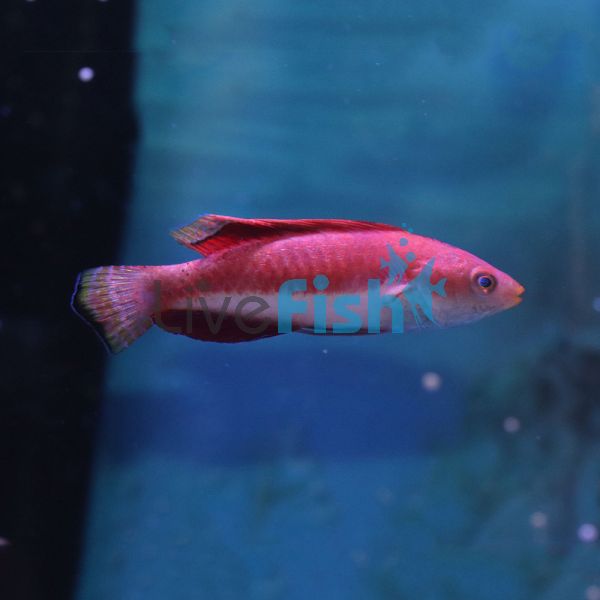Wrasse Blue Throated Fairy - Medium
Blue Throated Fairy Wrasse - This species of fairy wrasse is relatively newly defined and gaining popularity in the aquarium trade. It is often mistaken for a hybrid of other members of the same species. It distinguishes itself from other species in the same family by its strong blue pigmentation, especially in the throat area.
Blue Throated Fairy Wrasse
The Blue Throated Fairy Wrasse has a large flowing fin on top of its body which ranges in colour from a deep red to electric purple. They can grow to around 5 inches (13cm) and have a large neon blue patch underneath their chins for which they get their names.
The females of the species are slightly duller in colouring than their male counterparts. No known success has been reported when attempting to breed this species in captivity.
They can be quite shy when first introduced to the tank so don't be surprised it they hide for several days before showing their face again. This species doesn't bury itself at night to sleep like other wrasses, instead choosing to cover itself in a mucous cocoon and squeezing itself inside a rock crevice.
This is a great opportunity to own a fish that hasn't even been fully identified yet. Don't miss out!
These fish are only found near select islands in areas of the Philippines and Indonesia. They can be found around rubble slopes at depths ranging from 4 to 30 metres.
Tank Recommendations for Blue Throated Fairy Wrasse
The smallest tank size for this species of wrasse is 115 litres. Provide plenty of caves and crevices for them to hide in and explore. A medium grain sand substrate would be perfect and no special lighting or water movement requirements are necessary. These fish are well-renowned jumpers so a well-fitting aquarium lid is essential to prevent escapes. Egg crates can even be considered to avoid any harm coming to them. They will do well in both a fish only and reef tank environment.
Suitable Tank Buddies
Blue Throated Fairy Wrasse have a peaceful temperament but they will show aggression to other Fairy Wrasses. Only one of these species should ever be kept in the same tank at a time.
Usually Compatible
This species of wrasse will get along great with large species of Angelfish, Boxfish and Damselfish. Fancy Damselfish and Tangs will also be wonderful choices as tank buddies too.
Sometime Compatible
Keep an eye on smaller species of Angelfish, Blennies and Clownfish. Butterflyfish, Eels and Filefish should only be kept together with caution as well. Other species to consider carefully include Groupers, Grunts and Hogfish. Lionfish, Parrotfish and Pufferfish should be fine too but be cautious.
Rarely Compatible
Small crustaceans and invertebrates shouldn't be kept in the same tank as they will most likely get picked at. Other species that should be avoided are Batfish. Sharks will almost certainly see the wrasse as prey and docile species such as Seahorses and Pipefish will get too upset by the wrasse's boisterous nature.
Feeding your Blue Throated Fairy Wrasse
These creatures are carnivorous and in the wild are big zooplankton munchers. In the tank, though they will consume most types of aquarium foods. Feed them 2-3 times a day and give them a wide variety of frozen and fresh meaty items that have been chopped finely. Good options include shrimp, clam and mysis shrimp.
| Scientific Name | Cirrhilabrus cyanogularis |
|---|---|
| Common Names | The Blue Throated Fairy Wrasse is also known as Sailfin Fairy Wrasse. |
| Diet | Carnivore |
| Fish Family | Labridae |
| Lifespan (years) | 10 |
| Max. Length (cm) | 13 |
| Min. Tank Volume (l) | 115 |
| Origin | Philippines and Indonesia |
| Reef Safe | Yes |
| Sociability | Peaceful |
| Venomous | No |
| Water Conditions | 23-27.8° C (74-82° F), dKH 8-12, pH 8.0-8.5, sg 1.020-1.026 |




